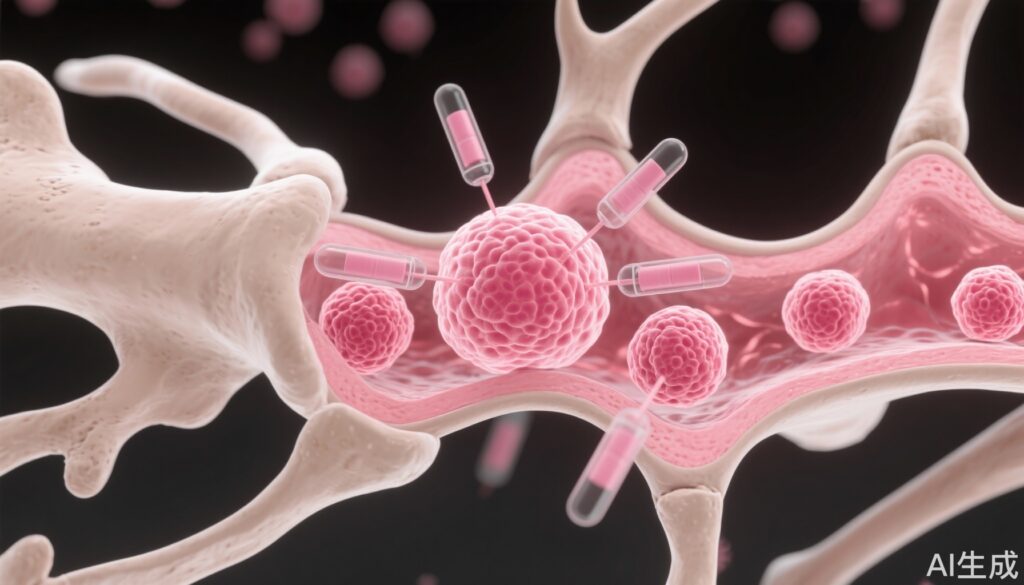Highlight
- Breast cancer recurrence is often driven by dormant disseminated tumor cells (DTCs) persisting in bone marrow and other niches.
- Preclinical mouse models identified autophagy and mTOR signaling as key regulators of tumor cell dormancy and reactivation.
- Inhibition of autophagy with hydroxychloroquine (HCQ) and mTOR signaling with everolimus (EVE) decreased residual tumor cell burden and improved recurrence-free survival (RFS) in a duration-dependent manner.
- The CLEVER phase 2 trial demonstrated that targeting dormant DTCs with HCQ, EVE, or their combination is safe, feasible, and leads to significant reductions or clearance of DTCs in breast cancer survivors within 5 years of diagnosis.
Study Background and Disease Burden
Breast cancer remains a leading cause of cancer-related mortality globally, with a significant clinical challenge posed by disease recurrence years after apparently successful primary treatment. Recurrence often results from disseminated tumor cells (DTCs) which evade therapy by adopting a dormant state and residing in the bone marrow or other sites. These dormant cells can persist undetected for years, eventually reactivating and leading to metastatic relapse. Clinically, the presence of bone marrow DTCs independently predicts higher risk of breast cancer recurrence and mortality.
Understanding and targeting the cellular and molecular mechanisms that maintain tumor dormancy or trigger escape is an unmet medical need critical to preventing recurrence. Prior preclinical studies have implicated autophagy—a cellular recycling process—and the mammalian target of rapamycin (mTOR) signaling pathway as crucial regulators of tumor dormancy and reactivation. Autophagy supports cancer cell survival under stress, and mTOR influences growth signaling. Synergistic targeting of these pathways thus presents a novel therapeutic strategy to eradicate dormant residual tumor cells, potentially reducing minimal residual disease and preventing relapse.
Study Design
The randomized phase 2 CLEVER trial was designed to translate preclinical insights into a clinical intervention for breast cancer survivors. Eligible participants were patients within five years of breast cancer diagnosis with clinically detectable DTCs confirmed by bone marrow aspiration.
Participants (n=51) were randomized to receive hydroxychloroquine (HCQ, n=15), everolimus (EVE, an mTOR inhibitor, n=15), or a combination of HCQ and EVE (n=21). The intervention consisted of three cycles aimed at transiently or chronically inhibiting autophagy and mTOR pathways. The study’s primary endpoints were feasibility and safety of these treatments, while secondary endpoints included reduction or clearance of DTCs and recurrence-free survival (RFS).
Key Findings
The CLEVER trial demonstrated that treatment with HCQ, EVE, or their combination was feasible and well-tolerated; only one patient discontinued early due to grade 3 toxicity. After a median follow-up of 42 months, the landmark 3-year RFS rates were 91.7% for HCQ, 92.9% for EVE, and 100% for the combination therapy group.
Importantly, patients who cleared DTCs had better clinical outcomes compared to those with persistent DTCs (hazard ratio for recurrence or death: 0.21; 95% confidence interval, 0.01 to 3.4), underscoring the clinical relevance of minimal residual disease depletion.
Bayesian analysis revealed high posterior probabilities (98-99.9%) that three cycles of HCQ, EVE, or their combination induced significant reductions or clearance of DTCs compared to historical observation alone. The estimated DTC reductions were 80% with HCQ, 78% with EVE, and 87% with the combination.
Parallel preclinical studies in mouse models with dormant residual tumor cells corroborated these findings, showing that mTOR inhibition alone, or combined with autophagy inhibition, decreased tumor cell burden and improved RFS in a duration-dependent manner. The inverse correlation between residual tumor cell number and RFS suggested that therapeutic depletion of dormant tumor cells directly mediated improved clinical outcomes.
Expert Commentary
The CLEVER trial represents a pioneering clinical translation of mechanisms underlying tumor dormancy into therapeutic intervention. By focusing on dormant DTCs, this approach addresses a key source fueling breast cancer recurrence, which conventional treatments often fail to eradicate.
Experts note that the dual targeting of autophagy and mTOR pathways is biologically plausible given their central roles in cellular survival and proliferation control. The safety profile of HCQ and EVE, both FDA-approved agents, further supports clinical utility and potential for broad applicability.
However, limitations include the modest sample size and relatively short follow-up, warranting larger definitive randomized controlled trials to confirm survival benefits. Additionally, the study population’s heterogeneity regarding tumor subtypes and prior treatments necessitates further stratification to identify patients most likely to benefit.
Future investigations could explore optimal treatment durations, combination regimens with other targeted agents or immunotherapies, and biomarker-guided patient selection.
Conclusion
This study provides compelling proof-of-concept evidence that targeting dormant disseminated tumor cells with hydroxychloroquine and everolimus is a feasible, safe, and biologically effective strategy to reduce minimal residual disease and potentially improve recurrence-free survival in breast cancer survivors.
By directly addressing the reservoir of dormant tumor cells responsible for late relapse, this novel approach lays the groundwork for a new paradigm in breast cancer management. Larger definitive trials are needed to validate these findings and establish clinical guidelines incorporating dormancy-targeted therapies to ultimately reduce breast cancer recurrence and improve patient outcomes.
References
1. DeMichele A, Clark AS, Shea E, Bayne LJ, Sterner CJ, Rohn K, et al. Targeting dormant tumor cells to prevent recurrent breast cancer: a randomized phase 2 trial. Nat Med. 2025 Sep 2. doi:10.1038/s41591-025-03877-3. Epub ahead of print. PMID: 40897974.
2. Pantel K, Alix-Panabières C. Bone marrow as a reservoir for disseminated tumor cells: a special source for liquid biopsy in cancer patients. Bonekey Rep. 2014;3:584.
3. Aguirre-Ghiso JA. Models, mechanisms and clinical evidence for cancer dormancy. Nat Rev Cancer. 2007 Nov;7(11):834-46.
4. White E. The role for autophagy in cancer. J Clin Invest. 2015 Jan;125(1):42-6.
5. Zoncu R, Efeyan A, Sabatini DM. mTOR: from growth signal integration to cancer, diabetes and ageing. Nat Rev Mol Cell Biol. 2011 Jan;12(1):21-35.
6. André F, Ciruelos E, Rubovszky G, Campone M, Loibl S, Rugo HS, et al. Alpelisib for PIK3CA-Mutated, Hormone Receptor–Positive Advanced Breast Cancer. N Engl J Med. 2019 May 16;380(20):1929-40.



